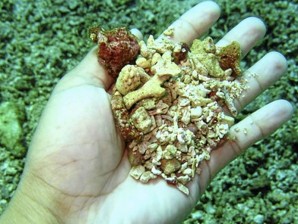5,000 ‘reefbuds’ to repair Boracay’s coral reef system
BORACAY ISLAND, Philippines— Appealing for drastic intervention, representatives of various sectors launched on Sunday a P60-million artificial reef project aimed at rehabilitating the island’s almost totally destroyed coral reef system.
The Code Blue project, which involves the placing of 5,000 “reefbuds” in a two-kilometer stretch parallel to Boracay’s shoreline, is considered the most extensive artificial reef project launched in the country, said Jose Rodriguez, vice chairman of the Sangkalikasan cooperative.
“Code Blue is a medical term for a critical situation when a patient is dying and in need of drastic intervention. Let us not wait for death to come,” Rodriguez said during the launch.
He said the project aimed to help stop the destruction of the island’s coral reefs estimated to be less than 10 percent of its original state based on various studies.
The hollow pyramid-shaped reefbud, which measures 1.2 meters by 1.2 m and weighs around 450-600 kilograms, is made from a mixture of organic and inorganic materials, said Benjie Tayag.
Tayag helped design the structures using locally made products from a design of Austrian geoscientist Harald Kremnitz.
The reefbuds, costing around P9,000 each, were also used in similar projects in Rosario town in Cavite and in Anilao in Mabini town in Batangas.
Tayag said the reefbud enhances the production of algae, which serves as fish food. Its hollow shape also serves as fish spawning ground.
But it will take years for the coral reefs and other marine life to recover. Coral reefs grow approximately a centimeter each year.
“We hope to recover from 20 to 30 percent of the coral reefs here in 10 years,” Tayag said in a press conference following the launching.
Felipe Huibonhua, Sangkalikasan chairman, said constant monitoring and regular inspections were needed to ensure that the reefbuds and the marine life that it would generate were protected.
Coral reefs act as home and nursing grounds of various fish species, and serve as natural buffer for strong waves. Their destruction is caused by many factors, including increased sea surface temperature, unregulated tourism and overfishing.
The destruction of coral reefs in Boracay is primarily blamed on unregulated fishing and boating activities when boats drop and drag their anchor on coral reefs.
Federico “Boy” Jarantilla, owner of the Sea Wind Boracay resort and a project partner, said he had observed the drastic reduction of coral reefs in the past 20 years in his constant diving.
“It’s like a graveyard of coral reefs down there,” he told the Inquirer.
He said the destruction of the coral reefs would eventually affect the famous white beach of the island because of dead corals being swept to the shoreline.
Huibonhua said they started placing clusters of reefbuds in January and is targeting the deployment of all 5,000 by May.
As of Sunday, 270 reefbuds have been deployed a kilometer from the shoreline by divers using a barge and crane.
Mayor John Yap of Malay town where Boracay is located said patrols would be intensified in the project area against illegal fishing and destructive boat activities. He said the current ban on fishing 500 m from the shoreline could be also extended.
Elena Brugger of the Philippine Chamber of Commerce and Industry (PCCI)-Boracay said environmental conservation and rehabilitation projects had become more urgent in Boracay due to the continued increase in tourist arrivals.
Tourist arrivals on the island have constantly increased reaching 908,875 last year and generating P14 billion in revenues. Visitors on the island are expected to reach a million this year.
But the island’s environment has become critical after decades of unregulated development caused by the tourism boom. Environmental problems had plagued the island including flooding because wetlands were covered and developed to make way for resorts and hotels.
The partners of the project include the Cooperative Development Authority, Malay municipal government, Boracay Association of Scuba-diving Schools, PCCI-Boracay, Sea Wind Boracay resort, White House Boracay resort, Boracay Regency, Philippine National Red Cross-Boracay-Malay Chapter and the Don Ciriaco Seneres Tirol Sr. Foundation.















